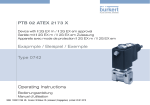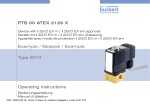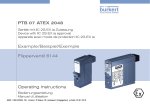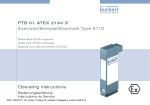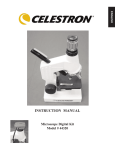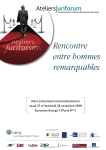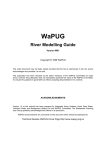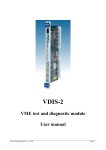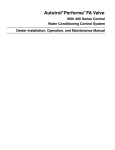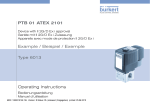Download Operating Instructions PTB 03 ATEX 1030 X
Transcript
PTB 03 ATEX 1030 X Device with II 2G/D Ex approval Geräte mit II 2G/D Ex Zulassung Appareils avec mode de protection II 2G/D Ex Example/Beispiel/Exemple Coil type 0780 with valve body type 0330 Spule Typ 0780 mit Gehäuse Typ 0330 Bobine type 0780 avec le corps type 0330 Operating Instructions Bedienungsanleitung Manuel d‘utilisation We reserve the right to make technical changes without notice. Technische Änderungen vorbehalten. Sous resérve de modification techniques. © 2008 - 2013 Bürkert Werke GmbH Operating Instructions 1309/12_EU-ML_00804717 / Original DE PTB 03 ATEX 1030 X Device with II 2G/D Ex certification 1. The Operating Instructions..........................................................4 1.1.Symbols............................................................................................... 4 2. Intended Use.................................................................................................5 2.1.Restrictions......................................................................................... 5 2.2.Ex-Approval........................................................................................ 5 2.3.Special instructions in explosion-risk areas................................ 6 3. General Safety Instructions......................................................6 4. General Information............................................................................7 4.1.Contact Address............................................................................... 7 4.2.Warranty.............................................................................................. 7 4.3.Information on the Internet.............................................................. 7 7.4.Disassembly.....................................................................................14 8. Start-up.......................................................................................................... 14 8.1.Safety Instructions..........................................................................14 9. Maintenance, Repair, Troubleshooting.......................... 15 9.1.Maintenance and repair.................................................................15 9.2.Troubleshooting...............................................................................15 10. Accessories............................................................................................ 15 10.1.Spare parts.....................................................................................15 11. Transport, Storage, Disposal............................................... 16 5. Application Conditions......................................................................8 5.1.Special conditions............................................................................ 8 6. Technical data / Safe operation...............................................9 6.1.Conformity.......................................................................................... 9 6.2.Standards............................................................................................ 9 6.3.Operating Conditions....................................................................... 9 6.4.General Technical Data.................................................................11 7. Assembly and disassembly.......................................................... 12 7.1.Safety Instructions..........................................................................12 7.2.Installation of valve..........................................................................13 7.3.Electrical connection......................................................................13 english 3 PTB 03 ATEX 1030 X The Operating Instructions 1. The Operating Instructions The operating instructions describe the entire life cycle of the device. Keep these instructions in a location which is easily accessible to every user and make these instructions available to every new owner of the device. The operating instructions contain important safety information! Failure to observe these instructions may result in hazardous situations. The operating instructions must be read and understood. • Carefully read the operating instructions before using the device. • In particular observe the chapter entitled “Intended Use”, and “General Safety Instructions” as well as the chapter entitled „Application Conditions“. 1.1. Symbols In the instructions, the following symbols are used to identify important information: Danger! Warns of an immediate danger! • Failure to observe the warning may result in a fatal or serious injury. Warning! Warns of a potentially dangerous situation! • Failure to observe the warning may result in serious injuries or death. Caution! Warns of a possible danger! • Failure to observe the warning may result in moderately serious or minor injuries. Note! Warns of damage to property! Important tips and recommendations. Refers to information in these operating instructions or in other documentation. →→designates a procedure which you must carry out. 4 english PTB 03 ATEX 1030 X Intended Use 2. Intended Use 2.1. Restrictions Incorrect use may be a hazard to people, nearby equipment and the environment. • The device serves exclusively as a solenoid valve for the media stated in the data sheet and for use in Explosion Group IIC, Category 2G and Temperature Class T4 or T5 (see data on the - Ex approval plate). • The device may be used only in category 2D with the temperatures T135 °C and/or 100 °C as well as for the designated application cases specified in chapter “5. Application Conditions” and in conjunction with third-party devices and components recommended and authorized by Bürkert. • The applied ignition protection types are the pressure-resistant casing “d” with increased safety “e”. The safety fuse incorporated in version PD29 is executed in ignition protection type encapsulation “m”. The proximity switch, which can be optionally incorporated in all versions, is executed in ignition protection type intrinsic safety “ia”. The composition of the ignition protection code follows the ignition protection types of the components used in each case. • Correct transportation, correct storage and installation and careful use and maintenance are essential for reliable and problem-free operation. If exporting the device, observe any existing restrictions. Any other use is considered improper use. Bürkert is not liable for any resulting damage. The user alone bears the risk. • Use the device only as intended. The EC type approval test certificate can be found on the Internet at: www.burkert.com 2.2. Ex-Approval The Ex approval is only valid if you use the modules and components authorised by Bürkets in such a way as described in this operating manual. The coil type 0770/0780 may only be used in combination with additional components that have been approved by Bürkert. Otherwise, the Ex approval will expire! If you make any unauthorized changes to the device, the modules or the components, the Ex approval will also expire. The EC Qualification Test Certificate PTB 03 ATEX 1030 X and the IECEx Certificate of Conformity IECEx PTB 05.0026X has been drawn up by the: TB (Physikalisch Technische Bundesanstalt) P Bundesallee 100 38116 Braunschweig who also audited the manufacture (CE0102). english 5 PTB 03 ATEX 1030 X General Safety Instructions 2.3. Special instructions in explosion-risk areas Warning! Danger caused by electrostatic charge! If there is a sudden discharge from electrostatically charged devices or persons, there is a danger of explosion in the explosion-risk area. • Take appropriate measures to prevent electrostatic charges in explosion-risk areas. • Clean the device surface by gently wiping it with a damp or antistatic cloth only. 3. General Safety Instructions These safety instructions do not take into account • any contingencies or events which may occur during the installation, operation and maintenance of the devices. • local safety regulations, the observance of which is the responsibility of the operator, also with respect to the installation personnel. Danger of explosion! • The device is a sealed system. It must not be opened Danger of electrostatic charge! Additional special conditions can be found under “5.1” of these operating instructions. Acute risk of injury from hazardous structure-borne voltage! Risk of damage to the device due to short circuit! • Before starting work, switch off the power supply and secure to prevent it being switched on again! • Observe the applicable accident prevention and safety regulations for electrical devices! Danger - high pressure! • There is a serious risk of injury when reaching into the equipment. • Before loosening the lines and valves, turn off the pressure and vent the lines. • Observe the currently valid accident prevention and safety regulations! 6 english PTB 03 ATEX 1030 X General Information 4. General Information Danger of explosion caused by electrostatic charge! 4.1. Contact Address If there is a sudden discharge from electrostatically charged devices or persons, there is a danger of explosion in the Ex area. • Take appropriate measures to prevent electrostatic charges in the Ex area. • Clean the device surface by gently wiping it with a damp or antistatic cloth. Germany General hazardous situations. To prevent injury, ensure that: • That the system cannot be activated unintentionally. • That no unauthorized changes are performed on the system. • Only expert and instructed personnel with appropriate tools carry out any work on the system. • The device may be operated only when in perfect condition and in consideration of the operating instructions. • The general rules of technology apply to application planning and operation. Bürkert Fluid Control Systems Sales Center Chr.-Bürkert-Str. 13-17 D-74653 Ingelfingen Tel. + 49 (0) 7940 - 10 91 111 Fax + 49 (0) 7940 - 10 91 448 E-mail: [email protected] International Contact addresses can be found on the final pages of the printed operating instructions. And also on the Internet under: www.burkert.com 4.2. Warranty The warranty is only valid if the device is used as intended in accordance with the specified application conditions. 4.3. Information on the Internet The operating manual and the data sheets can be found on the Internet under: www.burkert.com english 7 PTB 03 ATEX 1030 X Application Conditions 5. Application Conditions 5.1. Special conditions 5.1.1. Short-circuit protection Each electromagnet shall be provided on the line with a short-circuit protection in the form of a fuse designed to meet the magnet starting current (max. 3 x Irating in accordance with IEC 60127-2-1) or a motor overload trip instantaneous short-circuit and thermal release (Adjustment to match the pull-in current). Fuse ... A • At very low pull-in currents of the solenoid the fuse with the lowest current value is adequate according to the stated IEC standard. This fuse may be mounted in the associated supply unit or must be connected in series separately. 5.1.2. Operation with associated valve body • The rated voltage of the fuse must be equal to or larger than the quoted nominal voltage of the magnet. The solenoid coils Type 77. / 78. may only be operated with a valve body satisfying the following requirements. • The switch-off capability of the fuse cartridge must be equal to or greater than the maximum theoretical short-circuit current at the installation location (normally 1500 A). For the valve body, the following materials may be used: • In the case of versions PD30 of the solenoid, short-circuit protection must be assured by the operator. • In the case of version PD29 of the solenoid, the fuse is installed in the terminal box of the device. More detailed descriptions are to be found in the section “6. Technical data / Safe operation”. 8 english • metal (brass, aluminium, stainless steel) or • plastics (e,g, polyamide PA 6 GV ...) 5.1.3. Manual operation / approximity switch The solenoid armature can be manually operated via the push button. The push button may be locked by depressing and turning by 90°. As an alternative to manual operation, the solenoid can be equipped with a proximity switch. The internal code for this version is CF 15. PTB 03 ATEX 1030 X Technical data / Safe operation 5.1.4. Model with a terminal box Danger! Risk of explosion! • Only permanently laid cables and wiring may be inserted. • The operator must provide suitable stress relief. • Wires with an outside diameter of 6 to 13 mm may be used. Observe the maximum thermal loading of the cables or wires to be inserted. • The inserted break-off seal must be matched to the diameter of the cable or wire. • The rated cross-section of the cable or wire strands must be at least 0.75 mm² and may not exceed 2.5 mm². • The screws for fixing the cover of the terminal box must be tightened with a torque of 1 Nm (± 5 %). The solenoid coils may also be executed with a terminal box, with or without fuse/contactor (to separate Design Type Inspection Certificate) as desired. For protection against inadvertent opening of the cover, the latter bears the marking: Open only when the voltage is switched off! 6. Technical data / Safe operation 6.1. Conformity The coil type 0770/0780 is compliant with the EC Directives according to the EC Declaration of Conformity. 6.2. Standards Refer to the EC type approval test certificate and/or the EC Declaration of conformity for the applicable standards verifying conformity with the EC directives. 6.3. Operating Conditions Danger! Risk of explosion by excedance technical data! Exceeding the technical data indicated on the type label increases the explosion risk! • Never exceed the technical data indicated on the type label! 6.3.1. Maximum permissible ambient temperature range Please observe the maximum permissible ambient temperature range given under Operating conditions of the coils for each type! Version Maximum permissible ambient temperature range 07xx -30 °C ... +55 °C english 9 PTB 03 ATEX 1030 X Technical data / Safe operation 6.3.2. Type of protection Type and design IP65 to EN 60529 (DIN VDE 0470 Part 1) Protection class, Temperature class 6.3.3. Location and description of the type label PTB approval number Warning notices Type label coil Type label IEC Ex Id. number of the coil, Date of manufacture Serial number of the coil, Inspection body Voltage (± 10 %), Current type, Power consumption Protection class - Temperature class IEC EX Approval number Fuse ...A Fig. 2: Description of the type label 6.3.4. Dimensions Connection type Fig. 1: 10 Length (mm) Width (mm) Height (mm) Molded-in cable 96 32 56 Terminal box with/ without safety fuse 123 60 113 Location of the type label english PTB 03 ATEX 1030 X Technical data / Safe operation 6.3.5. Type of explosion protection 6.4. General Technical Data The composition of the explosion protection code follows the explosion protection types of the components used in each case: 6.4.1. Electrical Data Solenoid with or without terminal box Solenoid with terminal box and fuse Solenoid without terminal box with proximity switch Solenoid with terminal box, fuse and proximity switch Type 77. - ... - ... - . 78. - ... - ... - . Temperature class T4 T5 II 2 D Ex tD A21 IP 65 T135 °C resp. T100 °C Type of current Universal Universal Rated voltage 24 ... 240 V 24 ... 240 V II 2 G Ex d e mb IIC T4 Voltage tolerance +10 % / -10 % +10 % / -10 % II 2 D Ex tD A21 IP65 T135 °C Rated current 0,085 ... 0,014 A 0,085 ... 0,014 A II 2 G Ex d e ia IIC T4 resp. T5 Pick-up current 01,66 ... 0,166 A 01,66 ... 0,166 A II 2 D Ex tD A21 IP65 T135 °C resp. T100 °C Pick-up power 40 W 40 W Power consumption for holding in equilibrium 3W 3W Max. number of switching actuations ca 20 / min 10 / min II 2 G Ex d e IIC T4 resp. T5 II 2 G Ex d e ia mb IIC T4 II 2 D Ex tD A21 IP65 T135 °C 6.4.2. Electrical connection Version code PD30* Execution * Permanently installed rubber sheathed cable of Type H05 RN-F3G0.75 english Internal Code ****JWxx 11 PTB 03 ATEX 1030 X Assembly and disassembly Version code PD30 PD29 *** Execution Internal Code ** Terminal box with cable bushing M20 x 1.5, without fuse JA02 Terminal box with threaded nipple M20 x 1.5, without fuse JA08 Terminal box with threaded nipple NPT 1/2, without fuse JA09 Terminal box with threaded nipple G 1/2, without fuse JA10 ** Terminal box with cable bushing M20 x 1.5 and fuse JA01 Terminal box with threaded nipple M20 x 1.5 and fuse JA05 Terminal box with threaded nipple NPT 1/2 and fuse JA06 Terminal box with threaded nipple G 1/2 and fuse JA07 * The connecting cable of solenoid Type 07xx must be laid permanently such that it is adequately protected from mechanical damage ** Cable bushing to separate Design Inspection Certificate *** Fuse protection PD29 to separate type approval test certificate **** Different cable lengths 12 english 7. Assembly and disassembly 7.1. Safety Instructions Danger! Danger of explosion! The device is a sealed system. The unit must not be dismantled! The following safety regulations must be observed: • The surface of the device may develop an electrostatic charge. In areas with an explosion hazard, the surface of the units may only be cleaned with a damp cloth. • Only permanently laid cables and wiring may be inserted. • The operator must provide suitable stress relief. • Wires with an outside diameter of 6 to 13 mm may be used. Observe the maximum thermal loading of the cables or wires to be inserted. • The inserted break-off seal must be matched to the diameter of the cable or wire. • The rated cross-section of the cable or wire strands must be at least 0.75 mm² and may not exceed 2.5 mm². • The screws for fixing the cover of the terminal box must be tightened with a torque of 1 Nm (±5%). • The connection nut (clamping nut) of the cable gland on the terminal box must be tightened with a torque of 1.5 Nm (± 5 %). PTB 03 ATEX 1030 X Assembly and disassembly Danger! Danger of high voltage! Acute risk of injury from hazardous structure-borne voltage! Risk of damage to the device due to short circuit! • Before starting work, switch off the power supply and secure to prevent it being switched on again! • Live terminals in the terminal box can cause electric shock, short circuit or explosion. Switch off the power supply before opening the terminal box. • The connecting cables to the electromagnets must be secure, and be laid so that they are adequately protected from mechanical damage. • Observe the applicable accident prevention and safety regulations for electrical devices! Warning! Danger - high pressure! Interventions in the pneumatic system represent an acute risk of injury. • First switch off pressure before disconnecting lines and valves. • Observe the flow direction during installation. • Observe the applicable accident prevention and safety regulations for pneumatic systems. 7.2. Installation of valve The solenoid valve can be mounted in any position. Preferably with solenoid system mounted at the top. Procedure: →→Clean pipelines. →→Connect a dirt trap upstream. →→Seal pipeline connections with PTFE tape. →→Screws in pipelines. Make certain the direction of flow is correct! →→Check valve for leakage. 7.3. Electrical connection Danger! Risk of injury due to electrical shock! • Before reaching into the system, switch off the electrical power supply and secure to prevent reactivation! • Observe applicable accident prevention and safety regulations for electrical equipment! If the protective conductor contact between coil and body is missing, there is danger of electrical shock! • Always connect protective conductor. • Check electrical continuity between coil and body. english 13 PTB 03 ATEX 1030 X Start-up The connection cable is encapsulated with the coil and cannot be removed. →→Attach the electrical connection. Start-up 8.1. Safety Instructions Warning! Danger due to improper operation! 7.4. Disassembly Danger! Risk of electric shock! There is a serious risk of injury when reaching into the equipment. • Only trained electrical engineers may work on the electrical system. • Before starting work, always switch off the power supply and safeguard to prevent re-activation! • Observe applicable accident prevention and safety regulations for electrical equipment! Procedure: →→Disconnect the power connection. →→Disconnect the valve body from the pipeline. Note! Malfunctions as a result of contamination! • In case of new installation, remove old PTFE tape from the connections. Residues or parts of the tape must not get into the pipeline. 14 8. english Improper operation may result in injuries as well as damage to the device and the area around it. • Before start-up, ensure that the operating personnel are familiar with and completely understand the contents of the operating instructions. • In particular observe the safety instructions and intended use. • The device may be started by adequately trained personnel only. Before commissioning, ensure that: • The device has been correctly installed, • The connections have been correctly made, • The device is not damaged, • All bolts are securely tightened. PTB 03 ATEX 1030 X Maintenance, Repair, Troubleshooting 9. Maintenance, Repair, Troubleshooting 9.1. Maintenance and repair Danger! Danger due to improper maintenance, repair and inspection work! • The maintenance and inspection work on the device may be carried out by authorized technicians only and with the appropriate tools! • Repairs on the device may only be carried out by the manufacturer! • When performing repair or maintenance work on the system, the valve may not be opened and the protective-conductor connection may not be disconnected! 9.2. Troubleshooting In the event of faults, make sure that: • the device has been installed according to the specifications, • the connection has been established properly, • the device is not damaged, • all screws have been tightened, • the voltage and pressure have been switched on, • the pipelines are free. 10. Accessories Caution! Risk of injury and / or damage by the use of incorrect parts! Incorrect accessories and unsuitable parts may cause injuries and damage the device and the surrounding area. • Use only original accessories and original spare supplied by Bürkert. 10.1. Spare parts For electromagnet models with terminal boxes, fuses of the Type 1058 with approval PTB 01 ATEX 2064 U can be used in Temperature Class T4. Fuse Type 1058 Order No. 0.063 A 0.080 A 0.100 A 0.125 A 0.160 A 0.200 A 0.315 A 0.400 A 0.500 A 0.630 A 0.800 A 153717 153745 153718 153719 153720 153731 153733 153734 153735 153736 153737 english 15 PTB 03 ATEX 1030X Transport, Storage, Disposal Fuse Type 1058 Order No. 1.000 A 1.250 A 1.600 A 2.000 A 3.150 A 153738 153739 153746 153740 153742 11. Transport, Storage, Disposal Note! Transport damages! Inadequately protected equipment may be damaged during transport. • During transportation protect the device against wet and dirt in shock-resistant packaging. • Avoid exceeding or dropping below the allowable storage temperature. Incorrect storage may damage the device. • Store the device in a dry and dust-free location! • Storage temperature: -40 … +60 °C. Damage to the environment caused by device components contaminated with media. • Ensure the device and packaging are disposed of in an environmentally sound manner. • Observe applicable regulations relating to refuse disposal and the environment. 16 english PTB 03 ATEX 1030 X Geräte mit II 2G/D Ex Zulassung 1. Bedienungsanleitung....................................................................... 18 1.1.Darstellungsmittel............................................................................18 7.4.Demontage.......................................................................................28 8. Inbetriebnahme....................................................................................... 28 2. BestimmungsgemäSSe Verwendung1����������������������������������� 19 2.1.Beschränkungen.............................................................................19 2.2.Ex-Zulassung....................................................................................19 2.3.Besondere Hinweise im Ex-Bereich...........................................20 9. Wartung, Reparatur, Fehlerbehebung............................ 29 9.1.Wartung und Reparatur.................................................................29 9.2.Fehlerbehebung...............................................................................29 3. Allgemeine Sicherheitshinweise........................................... 20 10. Ersatzteile................................................................................................ 29 10.1.Zubehör...........................................................................................29 4. Allgemeine Hinweise........................................................................... 21 4.1.Kontaktadressen..............................................................................21 4.2.Gewährleistung...............................................................................21 4.3.Informationen im Internet...............................................................21 11. Transport, Lagerung, Entsorgung.................................. 30 5. Einsatzbedingungen.......................................................................... 22 5.1.Besondere Bedingungen..............................................................22 6. Technische Daten / Sicherer Betrieb............................... 23 6.1.Konformität........................................................................................23 6.2.Normen..............................................................................................23 6.3.Betriebsbedingungen.....................................................................23 6.4.Allgemeine Technische Daten......................................................25 7. Montage und Demontage............................................................... 26 7.1.Sicherheitshinweise........................................................................26 7.2.Installation des Ventils....................................................................27 7.3.Elektrischer Anschluss...................................................................27 deutsch 17 PTB 03 ATEX 1030 X Bedienungsanleitung 1. Bedienungsanleitung 1.1. Darstellungsmittel Die Bedienungsanleitung beschreibt den gesamten Lebenszyklus des Geräts. Bewahren Sie diese Anleitung so auf, dass sie für jeden Benutzer gut zugänglich ist und jedem neuen Eigentümer des Geräts wieder zur Verfügung steht. Die Bedienungsanleitung enthält wichtige Informationen zur Sicherheit! Das Nichtbeachten dieser Hinweise kann zu gefährlichen Situationen führen. Die Anleitung muss gelesen und verstanden werden. • Lesen Sie die Bedienungsanleitung vor dem Einsatz des Geräts sorgfältig durch. • Beachten Sie vor allem die Kapitel „Bestimmungsgemäße Verwendung“, und „Allgemeine Sicherheitshinweise“ sowie das Kapitel „Einsatzbedingungen“. Für die Kennzeichnung wichtiger Informationen werden in der Anleitung folgende Darstellungsmittel verwendet: Gefahr! Warnt vor einer unmittelbaren Gefahr! • Bei Nichtbeachtung sind Tod oder schwere Verletzungen die Folge. Warnung! Warnt vor einer möglicherweise gefährlichen Situation! • Bei Nichtbeachtung drohen schwere Verletzungen oder Tod. Vorsicht! Warnt vor einer möglichen Gefährdung! • Nichtbeachtung kann mittelschwere oder leichte Verletzungen zur Folge haben. Hinweis! Warnt vor Sachschäden! • Bei Nichtbeachtung kann Gerät oder Anlage beschädigt werden. Bezeichnet wichtige Zusatzinformationen, Tipps und Empfehlungen. Verweist auf Informationen in dieser Bedienungsanleitung oder in anderen Dokumentationen. →→markiert einen Arbeitsschritt, den Sie ausführen müssen. 18 deutsch PTB 03 ATEX 1030 X Bestimmungsgemäße Verwendung 2. BestimmungsgemäSSe Verwendung Bei nicht bestimmungsgemäßem Einsatz können Gefahren für Personen, Anlagen in der Umgebung und die Umwelt entstehen. • Das Gerät dient ausschließlich als Magnetventil für die Iaut Datenblatt zulässigen Medien und für den Einsatz in Explosionsgruppe IIC, Kategorie 2G und Temperaturklasse T4 oder T5 (siehe Anga- Zulassungsschild). ben auf dem • Das Gerät darf nur für den Einsatz in Kategorie 2D mit den Temperaturen T135 °C bzw. 100 °C sowie für die im Kapitel „5. Einsatzbedingungen“ vorgesehenen Einsatzfällen und in Verbindung mit von Bürkert empfohlenen bzw. zugelassenen Fremdgeräten und -komponenten verwendet werden. • Die angewendeten Zündschutzarten sind die Druckfeste Kapselung „d“ mit Erhöhter Sicherheit „e“. Die Sicherung, die bei Ausführung PD29 eingebaut ist, ist in Zündschutzart Vergusskapselung „m“ ausgeführt. Der Näherungsschalter, der optional bei allen Ausführungen eingebaut werden kann, ist in Zündschutzart Eigensicherheit „ia“ ausgeführt. Die Zusammensetzung des Zündschutzartenkennzeichens richtet sich nach den Zündschutzarten der jeweils verwendeten Komponenten. • Voraussetzungen für den sicheren und einwandfreien Betrieb sind sachgemäßer Transport, sachgemäße Lagerung und Installation sowie sorgfältige Bedienung und Instanthaltung. Eine andere oder darüber hinausgehende Benutzung gilt als nicht bestimmungsgemäß. Für hieraus resultierende Schäden haftet Bürkert nicht. Das Risiko trägt allein der Anwender. • Das Gerät nur bestimmungsgemäß einsetzen. 2.1. Beschränkungen Beachten Sie bei der Ausfuhr des Systems/Geräts gegebenenfalls bestehende Beschränkungen. 2.2. Ex-Zulassung Die Ex-Zulassung ist nur gültig, wenn Sie die von Bürkert zugelassenen Module und Komponenten so verwenden, wie es in dieser Bedienungsanleitung beschrieben ist. Die Magnetspule Typ 0770/0780 darf nur in Kombination mit den von Bürkert freigegebenen Zusatzkomponenten eingesetzt werden, andernfalls erlischt die Ex-Zulassung! Nehmen Sie unzulässige Veränderungen am Gerät, den Modulen oder Komponenten vor, erlischt die Ex-Zulassung ebenfalls. Die EG-Baumusterprüfbescheinigung PTB 03 ATEX 1030 und das IECEx Certificate of Conformity IECEx PTB 05.0026X wurde von der: PTB (Physikalisch Technische Bundesanstalt) Bundesallee 100, 38116 Braunschweig ausgestellt, die auch die Fertigung auditiert (CE 102). Die EG-Baumusterprüfbescheinigung finden Sie im Internet unter: www.buerkert.de deutsch 19 PTB 03 ATEX 1030 X Allgemeine Sicherheitshinweise 2.3. Besondere Hinweise im Ex-Bereich Warnung! 3. Allgemeine Sicherheitshinweise Diese Sicherheitshinweise berücksichtigen keine: Gefahr durch elektrostatische Aufladung! Bei plötzlicher Entladung elektrostatisch aufgeladener Geräte oder Personen besteht im Ex-Bereich Explosionsgefahr. • Durch geeignete Maßnahmen sicherstellen, dass es im ExBereich zu keinen elektrostatischen Aufladungen kommen kann. • Die Geräteoberfläche nur durch leichtes Abwischen mit einem feuchten oder antistatischen Tuch reinigen. Weitere Besondere Bedingungen finden Sie unter „5.1“ in dieser Bedienungsanleitung. • Zufälligkeiten und Ereignisse, die bei Montage, Betrieb und Wartung der Geräte auftreten können. • ortsbezogenen Sicherheitsbestimmungen, für deren Einhaltung, auch in Bezug auf Montagepersonal, der Betreiber verantwortlich ist. Explosionsgefahr! • Das Gerät ist Teil eines geschlossenen Systems und darf nicht während des Betriebs demontiert werden. Gefahr durch elektrische Spannung! Akute Verletzungsgefahr durch gefährliche Korperspannung! Gefahr der Beschädigung des Geräts durch Kurzschluss! • Vor Eingriffen in das Gerät oder die Anlage, Spannung abschalten und vor Wiedereinschalten sichern! • Die geltenden Unfallverhütungs- und Sicherheitsbestimmungen für elektrische Geräte beachten! Gefahr durch hohen Druck! Bei Eingriffen in das System besteht akute Verletzungsgefahr. • Vor dem Lösen von Leitungen und Ventilen den Druck abschalten und die Leitungen entlüften. • Beim Einbau die Durchflussrichtung beachten. • Die geltenden Unfallverhütungs- und Sicherheitsbestimmungen für druckbeaufschlagte Geräte einhalten. 20 deutsch PTB 03 ATEX 1030 X Allgemeine Hinweise 4. Allgemeine Hinweise Explosionsgefahr durch elektrostatische Aufladung! 4.1. Kontaktadressen Bei plötzlicher Entladung elektrostatisch aufgeladener Geräte oder Personen besteht im Ex-Bereich Explosionsgefahr. • Durch geeignete Maßnahmen sicherstellen, dass es im ExBereich zu keinen elektrostatischen Aufladungen kommen kann. • Geräteoberfläche nur durch leichtes Abwischen mit einem feuchten oder antistatischen Tuch reinigen. Deutschland Allgemeine Gefahrensituationen. Zum Schutz vor Verletzungen ist zu beachten: • Dass die Anlage nicht unbeabsichtigt betätigt werden kann. • Am System dürfen keine unerlaubten Änderungen vorgenommen werden. • Arbeiten am System dürfen nur durch fachkundiges und unterwiesenes Personal mit geeignetem Werkzeug ausgeführt werden. • Das Gerät darf nur in einwandfreiem Zustand und unter Beachtung der Bedienungsanleitung betrieben werden. • Für die Einsatzplanung und den Betrieb müssen die allgemeinen Regeln der Technik eingehalten werden. Bürkert Fluid Control Systems Sales Center Chr.-Bürkert-Str. 13-17 D-74653 Ingelfingen Tel. + 49 (0) 7940 - 10 91 111 Fax + 49 (0) 7940 - 10 91 448 E-mail: [email protected] International Die Kontaktadressen finden Sie auf den letzten Seiten der gedruckten Bedienungsanleitung. Außerdem im Internet unter: www.burkert.com 4.2. Gewährleistung Voraussetzung für die Gewährleistung ist der bestimmungsgemäße Gebrauch des Geräts unter Beachtung der spezifizierten Einsatzbedingungen. 4.3. Informationen im Internet Bedienungsanleitungen und Datenblätter finden Sie im Internet unter: www.buerkert.de deutsch 21 PTB 03 ATEX 1030 X Einsatzbedingungen 5. Einsatzbedingungen 5.1. Besondere Bedingungen 5.1.1. Kurzschlussschutz Jedem Magneten muss als Kurzschlussschutz eine seinem Anzugsstrom entsprechende Sicherung (max. 3 x INenn nach IEC 60127-2-1) bzw. ein Motorschutzschalter mit Kurzschluss- und thermischer Schnellauslösung (Einstellung auf Anzugsstrom) vorgeschaltet werden. • Bei sehr kleinen Anzugsströmen des Magneten ist die Sicherung mit dem kleinsten Stromwert nach der genannten IEC-Norm ausreichend. Diese Sicherung darf im zugehörigen Versorgungsgerät untergebracht sein oder muss separat vorgeschaltet werden. • Die Sicherungs-Bemessungsspannung muss gleich oder größer als die angegebene Nennspannung des Magneten sein. • Das Ausschaltvermögen des Sicherungseinsatzes muss gleich oder größer als der maximal anzunehmende Kurzschlussstrom am Einbauort (üblicherweise 1500 A) sein. • Bei der Ausführung PD30 des Elektromagneten muss der Kurzschlussschutz durch den Betreiber gewährleistet werden. • Bei Ausführung PD29 des Elektromagneten ist die Sicherung im Klemmkasten des Geräts eingebaut. Nähere Beschreibung der Ausführungen finden Sie im Kapitel „6. Technische Daten / Sicherer Betrieb“. 22 deutsch Sicherung ... A 5.1.2. Betrieb nur mit zugehörigem Ventil Die Magnetspulen Typ 77. / 78. dürfen nur mit zugehörigem Ventilkörper betrieben werden. Als Ventilkörper können folgende Werkstoffe verwendet werden: • Metall (Messing, Aluminium, Edelstahl), • Kunststoff (z.B. Polyamid PA 6 GV ...). 5.1.3. Handbetätigung / Näherungsschalter Der Magnetanker kann über den Tastknopf manuell betätigt werden. Durch Eindrücken und Verdrehen um 90° wird der Tastknopf arretiert. Alternativ zur Handbetätigung kann der Elektromagnet mit einem Näherungsschalter ausgerüstet werden. Der interne Code für diese Ausführung ist CF 15. PTB 03 ATEX 1030 X Technische Daten / Sicherer Betrieb 5.1.4. Ausführung mit einem Klemmenkasten Gefahr! Explosionsgefahr! • Nur festgelegte Kabel und Leitungen dürfen eingeführt werden. • Der Betreiber muss eine entsprechende Zugentlastung gewährleisten. • Es können Leitungen mit Außendurchmesser von 6 mm bis 13 mm verwendet werden. Die maximale thermische Belastung der eingeführten Kabel bzw. Leitungen beachten. • Die eingelegte, ausbrechbare Dichtung muss dem Durchmesser des Kabel / Leitung angepasst werden. • Der Bemessungsquerschnitt der Kabel / Leitungsadern muss mindestens 0,75 mm² betragen und darf 2,5 mm² nicht überschreiten. • Die Schrauben zur Befestigung des Deckels des Klemmenkastens müssen mit einem Anziehdrehmoment von 1 Nm (± 5 %) angezogen werden. Die Magnetspulen dürfen auch mit einem Klemmenkasten (wahlweise mit / ohne Sicherung) ausgeführt werden (Sicherung nach getrennter Baumusterprüfbescheinigung). Als Schutz gegen unbeabsichtiges Öffnen des Deckels trägt dieser die Aufschrift: Nur spannungsfrei öffnen! 6. Technische Daten / Sicherer Betrieb 6.1. Konformität Die Magnetspule Typ 0770/0780 ist konform zu den EG-Richtlinien entsprechend der EG-Konformitätserklärung. 6.2. Normen Die angewandten Normen, mit denen die Konformität mit den EG-Richtlinien nachgewiesen wird, sind in der EG-Baumusterprüfbescheinigung und/oder der EG-Konformitätserklärung nachzulesen. 6.3. Betriebsbedingungen Gefahr! Explosionsgefahr durch Überschreitung technischen Daten! Überschreitung der auf dem Typschild angegebenen technischen Daten führt zu hohem Risiko! • Auf dem Typschild angegebenen technischen Daten keinesfalls überschreiten! 6.3.1. Maximal zulässiger Umgebungstemperaturbereich Bitte beachten Sie für jeden Typ den unter Einsatzbedingungen der Spule angegeben, maximal zulässigen Umgebungstemperaturbereich! Ausführung Maximal zulässiger Umgebungstemperaturbereich 07xx -30 °C ... +55 °C deutsch 23 PTB 03 ATEX 1030 X Technische Daten / Sicherer Betrieb 6.3.2. Schutzart Typ und Ausführung IP65 nach EN 60529 (DIN VDE 0470 Teil 1) Schutzart, Temperaturklasse 6.3.3. Lage und Beschreibung des Typschildes PTB Zulassungsnummer Warnhinweis Typschild Spule Typschild IEC Ex Identnummer der Spule, Herstellerdatum Seriennummer der Spule, Überwachungsstelle Schutzart - Temperaturklasse Sicherungswert / Fuse ...A IEC EX Zulassungsnummer Spannung (± 10 %), Stromart, Leistung Bild 2: Beschreibung des Typschildes 6.3.4. Abmessungen Bild 1: Lage des Typschildes Anschlussart 24 deutsch Länge (mm) Breite (mm) Höhe (mm) Eingepresstes Kabel 96 32 56 Klemmenkasten mit/ohne Sicherung 123 60 113 PTB 03 ATEX 1030 X Technische Daten / Sicherer Betrieb 6.3.5. Zündschutzarten 6.4. Allgemeine Technische Daten Die Zusammensetzung des Zündschutzartenkennzeichens richtet sich nach den Zündschutzarten der jeweils verwendeten Komponenten: 6.4.1. Elektrische Daten Elektromagnet mit oder ohne Klemmenkasten II 2 G Ex d e IIC T4 bzw. T5 II 2 D Ex tD A21 IP 65 T135 °C bzw. T100 °C Elektromagnet mit II 2 G Ex d e mb IIC T4 Klemmenkasten II 2 D Ex tD A21 IP65 T135 °C und Sicherung Elektromagnet II 2 G Ex d e ia IIC T4 bzw. T5 ohne KlemII 2 D Ex tD A21 IP65 T135 °C bzw. T100 °C menkasten mit Näherungsschalter Elektromagnet II 2 G Ex d e ia mb IIC T4 mit KlemmenII 2 D Ex tD A21 IP65 T135 °C kasten und Sicherung sowie Näherungsschalter Typ Temperaturklasse Stromart 77. - ... - ... - . 78. - ... - ... - . T4 T5 Allstrom Allstrom 24 ... 240 V 24 ... 240 V Spannungstoleranz +10 % / -10 % +10 % / -10 % Bemessungsstrom 0,085 ... 0,014 A 0,085 ... 0,014 A Anzugsstrom 01,66 ... 0,166 A 01,66 ... 0,166 A Anzugsleistung 40 W 40 W Grenzleistung im Beharrungszustand 3W 3W 20 / min 10 / min Nennspannung Max. Schalthäufigkeit ca. 6.4.2. Elektrischer Anschluss Ausführungscode PD30* Ausführung * Fest eingebaute Gummischlauchleitung des Typs H05 RN-F3G0,75 deutsch Interner Code ****JWxx 25 PTB 03 ATEX 1030 X Montage und Demontage Ausführungscode PD30 PD29 *** Ausführung Interner Code ** Klemmenkasten mit Kabelverschraubung M20 x 1,5 ohne Sicherung JA02 Klemmenkasten mit Gewindenippel M20 x 1,5 ohne Sicherung JA08 Klemmenkasten mit Gewindenippel NPT 1/2 ohne Sicherung JA09 Klemmenkasten mit Gewindenippel G 1/2 ohne Sicherung JA10 ** Klemmenkasten mit Kabelverschraubung M20 x 1,5 und Sicherung JA01 Klemmenkasten mit Gewindenippel M20 x 1,5 und Sicherung JA05 Klemmenkasten mit Gewindenippel NPT 1/2 und Sicherung JA06 Klemmenkasten mit Gewindenippel G 1/2 und Sicherung JA07 * Die Anschlussleitung des Elektromagneten Typ 07xx muss fest und so verlegt werden, dass sie vor mechanischen Beschädigungen hinreichend geschützt ist ** Kabelverschraubung nach getrennter Baumusterprüfbescheinigung *** Sicherung PD29 nach getrennter Baumusterprüfbescheinigung **** Unterschiedliche Kabellängen 26 deutsch 7. Montage und Demontage 7.1. Sicherheitshinweise Gefahr! Explosionsgefahr! Das Gerät ist ein geschlossenes System. Es darf nicht demontiert werden. Folgende Sicherheitsfestlegungen sind einzuhalten: • Die Oberfläche des Geräts kann sich elektrostatisch aufladen. In explosionsgefährdeten Bereichen darf die Oberfläche der Geräte nur mit einem feuchten oder antistatischen Tuch gereinigt werden. • Nur festgelegte Kabel und Leitungen dürfen eingeführt werden. • Der Betreiber muss eine entsprechende Zugentlastung gewährleisten. • Leitungen mit Außendurchmesser von 6 mm ... 13 mm können verwendet werden. Die maximale thermische Belastung der eingeführten Kabel bzw. Leitungen beachten. • Die eingelegte, ausbrechbare Dichtung muss dem Durchmesser des Kabels / Leitung angepasst werden. • Der Bemessungsquerschnitt der Kabel / Leitungsadern muss mindestens 0,75 mm² betragen und darf 2,5 mm² nicht überschreiten. • Die Schrauben zur Befestigung des Deckels des Klemmenkastens müssen mit einem Anziehdrehmoment von 1 Nm (± 5 %) angezogen werden. • Die Überwurfmutter (Druckschraube) der Kabelverschraubung am Klemmenkasten muss mit einem Anzugsdrehmoment von 1,5 Nm (± 5 %) angezogen werden. PTB 03 ATEX 1030 X Montage und Demontage Gefahr! Gefahr durch elektrische Spannung! Akute Verletzungsgefahr durch gefährliche Korperspannung! Gefahr der Beschädigung des Gerätes durch Kurzschluss! • Vor Eingriffen in das Gerät oder die Anlage, Spannung abschalten und vor Wiedereinschalten sichern! • Spannungsführende Klemmen im Klemmenkasten können Stromschlag, Kurzschluss oder Explosion verursachen. Spannung abschalten. Erst dann den Klemmkasten öffnen. • Die Anschlussleitungen der Elektromagneten müssen fest und so verlegt werden, dass sie vor mechanischen Beschädigungen hinreichend geschützt sind. • Die geltenden Unfallverhütungs- und Sicherheitsbestimmungen für elektrische Geräte beachten! Warnung! Gefahr durch hohen Druck! Bei Eingriffen in das System besteht akute Verletzungsgefahr. • Vor dem Lösen von Leitungen und Ventilen den Druck abschalten und die Leitungen entlüften. • Beim Einbau die Durchflussrichtung beachten. • Die geltenden Unfallverhütungs- und Sicherheitsbestimmungen für druckbeaufschlagte Geräte einhalten. 7.2. Installation des Ventils Die Einbaulage des Magnetventils ist beliebig. Vorzugsweise mit Magnetsystem oben. Vorgehensweise: →→Rohrleitungen reinigen. →→Schmutzfänger vorschalten. →→Anschlüsse der Rohrleitung mit PTFE-Band abdichten. →→Rohrleitungen einschrauben. Durchflussrichtung beachten! →→Ventil auf Dichtheit prüfen. 7.3. Elektrischer Anschluss Gefahr! Verletzungsgefahr durch Stromschlag! • Vor Eingriffen in das System die elektrische Spannung abschalten und vor Wiedereinschalten sichern! • Die geltenden Unfallverhütungs- und Sicherheitsbestimmungen für elektrische Geräte beachten! Bei fehlendem Schutzleiterkontakt zwischen Spule und Gehäuse besteht die Gefahr des Stromschlags! • Schutzleiter immer anschließen. • Elektrischer Durchgang zwischen Spule und Gehäuse prüfen. deutsch 27 PTB 03 ATEX 1030 X Inbetriebnahme Das Anschlusskabel ist mit der Spule vergossen und kann nicht demontiert werden. →→Elektrischer Anschluss anbringen. Inbetriebnahme Warnung! Verletzungsgefahr bei unsachgemäßem Betrieb! 7.4. Demontage Gefahr! Gefahr durch elektrische Spannung! Bei Eingriffen in die Anlage besteht akute Verletzungsgefahr. • Arbeiten am elektrischen System dürfen nur von ausgebildeten Elektrofachkräften durchgeführt werden. • Vor Beginn der Arbeiten in jedem Fall die Spannung abschalten und diese vor Wiedereinschalten sichern! • Die geltenden Unfallverhütungs- und Sicherheitsbestimmungen für elektrische Geräte beachten! Nicht sachgemäßer Betrieb kann zu Verletzungen, sowie Schäden am Gerät und seiner Umgebung führen. • Vor der Inbetriebnahme muss gewährleistet sein, dass der Inhalt der Bedienungsanleitung dem Bedienungspersonal bekannt ist und vollständig verstanden wurde. • Die Sicherheitshinweise und die bestimmungsgemäße Verwendung müssen beachtet werden. • Nur ausreichend geschultes Personal darf die Anlage/das Gerät in Betrieb nehmen. Stellen Sie vor Inbetriebnahme sicher, dass: • das Gerät vorschriftmäßig installiert wurde, Vorgehensweise: • der Anschluss ordnungsgemäß ausgeführt wurde, →→Elektrische Verbindung trennen. →→Ventilgehäuse von der Rohrleitung trennen. • das Gerät nicht beschädigt ist, • alle Schrauben fest angezogen sind. Hinweis! Funktionsstörungen durch Verschmutzung! • Bei Neuinstallation altes PTFE-Band an den Anschlüssen entfernen. Reste oder Teile des Bandes dürfen nicht in die Rohrleitung gelangen. 28 8. deutsch PTB 03 ATEX 1030 X Wartung, Reparatur, Fehlerbehebung 9. Wartung, Reparatur, Fehlerbehebung 9.1. Wartung und Reparatur Gefahr! Gefahr durch unsachgemäße Wartungs-, Reparatur- und Instandhaltungsarbeiten! • Die Wartungs- und Instandhaltungsarbeiten am Gerät dürfen nur autorisiertes Fachpersonal mit geeignetem Werkzeug durchführen! • Reparaturen am Gerät dürfen nur vom Hersteller durchgeführt werden! • Bei Repatatur- oder Wartungsarbeiten an der Anlage darf das Ventil nicht geöffnet und die Schutzleiterverbindung nicht getrennt werden! 9.2. Fehlerbehebung Stellen Sie bei Störungen sicher, dass: • das Gerät vorschriftmäßig installiert wurde, • der Anschluss ordnungsgemäß ausgeführt wurde, • das Gerät nicht beschädigt ist, • alle Schrauben fest angezogen sind, • Spannung und Druck anliegen, • die Rohrleitungen frei sind. 10. Ersatzteile Vorsicht! Verletzungsgefahr, Sachschäden durch falsche Teile! Falsches Zubehör und ungeeignete Ersatzteile können Verletzungen und Schäden am Gerät und dessen Umgebung verursachen. • Nur Originalzubehör sowie Originalersatzteile der Firma Bürkert verwenden. 10.1. Zubehör Bei Ausführung der Geräte mit Klemmenkasten kann in Temperaturklasse T4, die Sicherung des Typs 1058 mit Zulassung PTB 01 ATEX 2064 U eingesetzt werden. Sicherung Typ 1058 Bestellnummer 0,063 A 0,080 A 0,100 A 0,125 A 0,160 A 0,200 A 0,315 A 0,400 A 0,500 A 0,630 A 0,800 A 153717 153745 153718 153719 153720 153731 153733 153734 153735 153736 153737 deutsch 29 PTB 03 ATEX 1030 X Transport, Lagerung, Entsorgung Sicherung Typ 1058 Bestellnummer 1,000 A 1,250 A 1,600 A 2,000 A 3,150 A 153738 153739 153746 153740 153742 11. Transport, Lagerung, Entsorgung Hinweis! Transportschäden! Unzureichend geschützte Geräte können durch den Transport beschädigt werden. • Gerät vor Nässe und Schmutz geschützt in einer stoßfesten Verpackung transportieren. • Eine Über- bzw. Unterschreitung der zulässigen Lagertemperatur vermeiden. Falsche Lagerung kann Schäden am Gerät verursachen. • Gerät trocken und staubfrei lagern! • Lagertemperatur: –40 … +60 °C. Umweltschäden durch von Medien kontaminierte Geräteteile. • Gerät und Verpackung umweltgerecht entsorgen! • Geltende Entsorgungsvorschriften und Umweltbestimmungen einhalten. 30 deutsch PTB 03 ATEX 1030 X Appareils avec mode de protection II 2G/D Ex 1. À propos de ce manuel.................................................................... 32 1.1.Symboles..........................................................................................32 2. Utilisation conforme....................................................................... 33 2.1.Limitations.........................................................................................33 2.2.Homologation Ex.............................................................................33 2.3.Remarques particulières dans une zone présentant des risques d’explosion..................................................................................34 3. Consignes de sécurité fondamentales.......................... 34 4. Indications générales..................................................................... 35 4.1.Adresses...........................................................................................35 4.2.Garantie légale.................................................................................35 4.3.Informations sur Internet................................................................35 7.2.Installation de la vanne...................................................................41 7.3.Raccordement électrique..............................................................41 7.4.Démontage.......................................................................................42 8. Mise en service........................................................................................ 42 9. Entretien, réparation, dépannage........................................ 43 9.1.Entretien et réparation....................................................................43 9.2.Dépannage.......................................................................................43 10. Accessoires............................................................................................ 43 10.1.Pièces de rechange.....................................................................43 11. Transport, Stockage, Élimination...................................... 44 5. Conditions d‘emploi des appareils...................................... 36 5.1.Conditions particulières.................................................................36 6. Caractéristiques techniques / fonctionnement en toute sécurité....................................................................................... 37 6.1.Conformité........................................................................................37 6.2.Normes..............................................................................................37 6.3.Conditions d‘exploitation...............................................................37 6.4.Caractéristiques techniques générales.....................................39 7. Montage et Démontage................................................................... 40 7.1.Consignes de sécurité...................................................................40 français 31 PTB 03 ATEX 1030 X À propos de ce manuel 1. À propos de ce manuel Ce manuel décrit le cycle de vie complet de l‘appareil. Conservez ce manuel de sorte qu‘il soit accessible à tout utilisateur et à disposition de tout nouveau propriétaire. Les instructions de service contiennent des informations importantes sur la sécurité. Le non-respect de ces consignes peut entraîner des situations dangereuses. Les instructions de service doivent être lues et comprises. • Lisez attentivement les instructions de service avant d’utiliser l’appareil. • Faites particulièrement attention aux chapitres « Utilisation conforme », et « Consignes de sécurité fondamentales » ainsi que les « Conditions d‘emploi des appareils ». 1.1. Symboles Les moyens de représentation suivants sont utilisés dans le manuel pour identifier les informations importantes : Danger ! Met en garde contre un danger imminent ! • Le non-respect peut entraîner la mort ou de graves blessures. Avertissement ! Met en garde contre une situation éventuellement dangereuse ! • Risque de blessures graves, voire la mort en cas de non-respect. Attention ! Met en garde contre un risque possible ! • Le non-respect peut entraîner des blessures légères ou de moyenne gravité. Remarque ! Met en garde contre des dommages matériels ! Conseils et recommandations importants. Renvoie à des informations dans ces instructions de service ou dans d’autres documentations. →→identifie une opération que vous devez effectuer. 32 français PTB 03 ATEX 1030 X Utilisation conforme 2. Utilisation conforme 2.1. Limitations L’utilisation non conforme peut présenter des dangers pour les personnes, les installations proches et l’environnement. • L‘appareil sert exclusivement d‘électrovanne pour les fluides autorisés d‘après la fiche technique et pour l‘emploi dans un groupe déflagrant IIC, catégorie 2G et classe de température T4 ou T5 (voir indications sur la plaque d‘homologation ). • L’appareil doit être utilisé uniquement en catégorie 2D aux températures T135 °C resp. 100 °C ainsi que dans les cas prévus au chapitre « 5. Conditions d‘emploi des appareils » et en association avec des appareils et composants d’autres marques recommandés et homologués par Bürkert. • Les types de protection à l’allumage utilisés sont le coffret blindé antidéflagrant « d » avec sécurité accrue « e ». La sécurité installée dans la version PD29 est du type de protection à l’allumage par encapsulage « m ». Le détecteur de proximité pouvant être monté en option sur toutes les versions est du type de protection à l’allumage à sécurité intrinsèque « ia ». L’identification du type de protection à l’allumage est basée sur les types de protection à l’allumage des composants utilisés. • Les conditions pour l’utilisation sûre et parfaite sont un transport, un stockage et une installation dans les règles ainsi qu’une utilisation et maintenance parfaites. Toute autre utilisation ou toute utilisation allant au-delà est considérée comme non conforme. Bürkert décline toute responsabilité pour les dommages qui en résultent. L’utilisateur est seul à en supporter le risque. • Veillez à ce que l’utilisation de l’appareil soit toujours conforme. français Lors de l‘exportation du système / de l’appareil, veuillez respecter les limitations éventuelles existantes. 2.2. Homologation Ex L‘homologation Ex n‘est valable que si vous utilisez les modules et composants homologués par Bürkert tel que cela est décrit dans ces instructions de service. La soupape à languette peut être utilisée uniquement avec les composants supplémentaires autorisés par Bürkert, sinon l‘homologation Ex devient caduque ! L‘homologation Ex devient également caduque si vous apportez des modifications non autorisées à l‘appareil, aux modules ou aux composants. Le certificat d’examen CE de type PTB 03 ATEX 1030 X et le certificat de conformité IECEx PTB 05.0026X ont été établis par : TB (Physikalisch Technische Bundesanstalt) P Bundesallee 100, 38116 Braunschweig qui effectue également l‘audit de production (CE 0102). Vous trouverez le certificat d’essai de modèle type CE sur Internet sous : www.burkert.fr 33 PTB 03 ATEX 1030 X Consignes de sécurité fondamentales 2.3. Remarques particulières dans une zone présentant des risques d’explosion Avertissement ! Risque dû à la charge électrostatique. Il y a risque d’explosion en cas de décharge soudaine d’appareils ou de personnes chargés d’électricité statique dans des zones présentant des risques d’explosion. • Par des mesures appropriées, assurez-vous qu’il ne peut y avoir de charges électrostatiques dans de telles zones. • Nettoyer la surface de l’appareil uniquement en l’essuyant légèrement avec un chiffon humide ou antistatique. Vous trouverez d‘autres conditions particulières au chapitre « 5.1 » de ce manuel d‘utilisation. 3. Consignes de sécurité fondamentales Ces consignes de sécurité ne tiennent pas compte : • des hasards et des événements pouvant survenir lors du montage, de l‘exploitation et de l‘entretien des appareils. • des prescriptions de sécurité locales que l‘exploitant est tenu de faire respecter par le personnel chargé du montage. Risque d‘explosion. • La soupape à languette fait partie d‘un système fermé et ne peut pas être démontée pendant l‘exploitation. Danger par tension électrique. Risque de blessure grave en raison d’une tension corporelle dangereuse! • Avant de commencer une intervention, couper la tension et assurer une protection contre la remise en marche de l’appareil! • Respecter les règles de prévention des accidents et de sécurité en vigueur pour les appareils électriques! Danger dû à la haute pression. Il y a risque important de blessures lors d’interventions sur le système. • Couper d’abord la pression, puis détacher les câbles et les vannes. • Respecter les règles de prévention des accidents et de sécurité en vigueur pour les appareils pneumatiques. 34 français PTB 03 ATEX 1030 X Indications générales 4. Indications générales Risque d‘explosion dû à la charge électrostatique. 4.1. Adresses Il y a risque d‘explosion en cas de décharge soudaine d‘appareils ou de personnes chargés d‘électricité statique dans des zones présentant des risques d‘explosion. • Par des mesures appropriées, assurez-vous qu‘il ne peut y avoir de charges électrostatiques dans de telles zones. • Nettoyez la surface de la soupape à languette uniquement en essuyant légèrement avec un chiffon ou antistatique humide. Allemagne Situations dangereuses d‘ordre général. Pour prévenir les blessures, respectez ce qui suit : • L’actionnement par inadvertance de l’installation ne doit pas être possible. • Aucune modification non autorisée ne doit être apportée au système. • Les travaux sur le système doivent être exécutés uniquement par du personnel qualifié et formé disposant de l’outillage approprié. • L’appareil doit être utilisé uniquement en parfait état et en respectant le manuel d’utilisation. • Les règles générales de la technique sont d’application pour planifier l’utilisation et utiliser l’appareil. Bürkert Fluid Control Systems Sales Center Chr.-Bürkert-Str. 13-17 D-74653 Ingelfingen Tel. + 49 (0) 7940 - 10 91 111 Fax + 49 (0) 7940 - 10 91 448 E-mail : [email protected] International Les adresses se trouvent aux dernières pages de ces instructions de service imprimées. Egalement sur internet sous : www.burkert.com 4.2. Garantie légale La condition pour bénéficier de la garantie est l‘utilisation conforme de l‘appareil dans le respect des conditions d‘utilisation spécifiée. 4.3. Informations sur Internet Vous trouverez les instructions de service et la fiche technique sur Internet à l‘adresse : www.buerkert.fr français 35 PTB 03 ATEX 1030 X Conditions d‘emploi des appareils 5. Conditions d‘emploi des appareils 5.1. Conditions particulières 5.1.1. Protection contre les courts-circuits Un fusible correspondant au courant d‘actionnement (max. 3 x Irating selon CEI 60127-2-1) ou un disjoncteur de court-circuit et thermique à déclenchement rapide (réglage sur courant de démarrage) doit être monté en amont de chaque aimant. • Selon la norme CEI citée, le fusible au valeur de courant le plus faible suffit lorsque les courants évalués de l’aimant sont très faibles. Ce fusible peut être placé dans l’appareil d’alimentation s’y rattachant ou doit être branché séparément en amont. • La tension de calcul du fusible doit être égale ou supérieure à la tension nominale indiquée de l’aiment. • Le pouvoir de coupure de la cartouche doit être égal ou supérieur au courant de court-circuit supposé au lieu de montage (habituellement 1500 A). • Dans les versions PD30 de l‘électro-aimant, la protection contre les courts-circuits doit être assurée par l‘exploitant. • Dans la version PD29 de l‘électro-aimant, le fusible est monté dans la boîte de connexions de l‘appareil. Vous trouverez une description plus détaillée des versions au chapitre « 6. Caractéristiques techniques / fonctionnement en toute sécurité ». 36 Fusible ... A 5.1.2. Fonctionnement avec corps de soupape s‘y rattachant Les bobines magnétiques des type 77. / 78. ne doivent être mise en œuvre qu‘avec le corps de vanne s‘y rattachant. On peut utiliser comme corps de vanne les matières suivantes : • métal (p. ex. laiton, acier spécial...) ou • matière plastique (e. ex. polyamide, PVC, PTFE) 5.1.3. Commande manuelle / détecteur de proximité L’induit de l’aimant peut être manœuvré à la main par le bouton-poussoir. En pressant et tournant de 90°, le bouton-poussoir est bloqué. Alternativement à la commande manuelle, l’électro-aimant peut être équipé d’un détecteur de proximité. Le code interne pour cette version est CF 15. français PTB 03 ATEX 1030 X Caractéristiques techniques / fonctionnement en toute sécurité 5.1.4. Exécution avec boîte à bornes Danger ! Risque d‘explosion. • Uniquement des câbles et des lignes déterminés doivent être introduits. • L‘exploitant doit assurer une décharge de traction correspondante. • Des lignes ayant un diamètre extérieur de 6 mm à 13 mm peuvent être utilisées. Tenir compte de la charge thermique maximale es câbles ou des lignes introduits. • Le joint qui peut s‘arracher doit être adapté au diamètre du câble/ de la ligne. • La section de référence des conducteurs du câble/de la ligne doit mesurer au moins 0,75 mm² et ne doit pas dépasser 2,5 mm². • Les vis pour fixer le couvercle de la boîte de connexions doivent être serrées à un couple de 1 Nm (±5 %). Les bobines magnétiques peuvent être aussi réalisées avec une boîte de connexions (au choix avec ou sans fusible) - (fusible conforme au certificat d‘essai de type séparé). Comme protection contre toute ouverture involontaire du couvercle, ce dernier porte l‘inscription : À n‘ouvrir qu‘en absence de tension! français 6. Caractéristiques techniques / fonctionnement en toute sécurité 6.1. Conformité Les bobines magnétiques des type 0770/0780 est conforme aux directives CE sur la base de la déclaration de conformité CE. 6.2. Normes Les normes utilisées, avec lesquelles la conformité avec les directives CE sont prouvées, figurent dans l’attestation CE de type et/ou la déclaration de conformité CE. 6.3. Conditions d‘exploitation Avertissement ! Risque d‘explosion. Le non-respect des caractéristiques techniques visées sur la plaque signalétique induit des risques graves! • Toujours respecter les caractéristiques techniques figurant sur la plaque signalétique! 6.3.1. Plage de température de service Tenir compte pour chaque type de la plage de température de service figurant dans les conditions d’emploi des appareils. Version Plage de température ambiante maximale admissible 07xx -30 °C ... +55 °C 37 PTB 03 ATEX 1030 X Caractéristiques techniques / fonctionnement en toute sécurité 6.3.2. Mode de protection Type et version IP65 selon EN 60529 (DIN VDE 0470 partie 1) Type de protection, Classe de température 6.3.3. Emplacement et la description de la plaque signalétique N° d’homologation PTB Mise en garde Plaque signalétique bobine Plaque signalétique IEC Ex N° ID de la bobine, Date fabricant N° de série de la bobine, Organisme de surveillance Tension (± 10 %), Type de courant, Puissance Type de protection / classe de température Fusible / Fuse ...A N° d’homologation IEC Ex Fig. 1 : Emplacement de la plaque signalétique 38 Fig. 2 : Description de la plaque signalétique 6.3.4. Dimensions Mode de raccordement Longueur (mm) Largeur (mm) Hauteur (mm) Câble serti 96 32 56 Boîte à bornes avec/sans fusible 123 60 113 français PTB 03 ATEX 1030 X Caractéristiques techniques / fonctionnement en toute sécurité 6.3.5. Protection „e“ La composition des signes distinctifs de protection allumage s’oriente sur les modes de protection allumage des composants respectivement utilisés : 6.4. Caractéristiques techniques générales 6.4.1. Caractéristiques électriques Type 77. - ... - ... - . 78. - ... - ... - . II 2 D Ex tD A21 IP 65 T135 °C resp. T100 °C Classe de température T4 T5 Type de courant tous courants tous courants Electro-aimant avec coffret à bornes et fusible II 2 G Ex d e mb IIC T4 Tension nominale 24 ... 240 V 24 ... 240 V II 2 D Ex tD A21 IP65 T135 °C Tolérance de tension +10 % / -10 % +10 % / -10 % Electro-aimant sans coffret à bornes, avec détecteur de proximité II 2 G Ex d e ia IIC T4 resp. T5 Courant de calcul 0,085 ... 0,014 A 0,085 ... 0,014 A II 2 D Ex tD A21 IP65 T135 °C resp. T100 °C Courant d‘actionnement 01,66 ... 0,166 A 01,66 ... 0,166 A II 2 G Ex d e ia mb IIC T4 Puissance d´attraction 40 W 40 W II 2 D Ex tD A21 IP65 T135 °C Puissance de maintien en régime établi 3W 3W Electro-aimant avec ou sans coffret à bornes II 2 G Ex d e IIC T4 resp. T5 Electro-aimant avec coffret à bornes, fusible et détecteur de proximité Régime de charge max. 20 / min env. 10 / min 6.4.2. Raccordement électrique Code d’exécution PD30* français Version Code interne * Conduite flexible en caoutchouc montée fixe du type H05 RN-F3G0,75 ****JWxx 39 PTB 03 ATEX 1030 X Montage et Démontage Code d’exécution PD30 PD29 *** Version Interner Code ** Boîte de connexions avec passe câble à vis M20 x 1,5 sans fusible JA02 Boîte de connexions avec raccord fileté M20 x 1,5 sans fusible JA08 Boîte de connexions avec raccord fileté NPT 1/2, sans fusible JA09 Boîte de connexions avec raccord fileté G 1/2, sans fusible JA10 ** Boîte de connexions avec passe câble à vis M20 x 1,5 et fusible JA01 Boîte de connexions avec raccord fileté M20 x 1,5 et fusible JA05 Boîte de connexions avec raccord fileté NPT 1/2 et fusible JA06 Boîte de connexions avec raccord fileté G 1/2 et fusible JA07 * La ligne de raccordement de l‘électro-aimant Type 7..- doit être posée fixe et de manière à ce qu‘elle soit suffisamment à l‘abri de détériorations mécaniques. ** Passe câble à vis selon certificat d‘essai de type séparé 7. Montage et Démontage 7.1. Consignes de sécurité Danger ! Danger d‘explosion. L’appareil est un système fermé. L‘appareil ne doit pas être démonté. Il faut respecter les prescriptions de sécurité suivantes : • La surface de l’appareil peut emmagasiner une charge électrostatique. Dans les zones à risques de déflagration, la surface des appareils ne doit être nettoyée qu’avec un linge humide. • Uniquement des câbles et des lignes déterminés doivent être introduits. • L‘exploitant doit assurer une décharge de traction correspondante. • Des lignes ayant un diamètre extérieur de 6 mm à 13 mm peuvent être utilisées. Tenir compte de la charge thermique maximale es câbles ou des lignes introduits. • Le joint qui peut s‘arracher doit être adapté au diamètre du câble/ de la ligne. • La section de référence des conducteurs du câble/de la ligne doit mesurer au moins 0,75 mm² et ne doit pas dépasser 2,5 mm². • Les vis pour fixer le couvercle de la boîte de connexions doivent être serrées à un couple de 1 Nm (±5 %). • L’écrou-raccord (vis de pression) du passe-câbles sur le coffret à bornes doit être serré à un couple de 1,5 Nm (± 5 %). *** Fusible PD29 selon le certificat d’essai de modèle type CE séparé **** Différentes longueurs de câble 40 français PTB 03 ATEX 1030 X Montage et Démontage 7.2. Installation de la vanne Danger ! Danger par tension électrique. Risque de blessure grave en raison d’une tension corporelle dangereuse. • Les bornes conductrices de tension de la boîte de bornes peuvent causer des décharges électriques, des courts-circuits ou des explosions. Il convient de toujours couper la tension avant d’ouvrir la boîte de bornes. • Avant de commencer une intervention, couper la tension et assurer une protection contre la remise en marche de l’appareil. • Les lignes de raccordement des électro-aimants doivent solides et posées de manière à être suffisamment protégées contre des dommages d’origine mécanique. • Respecter les règles de prévention des accidents et de sécurité en vigueur pour les appareils électriques. La position de montage de l’électrovanne est indifférente. De préférence avec le système magnétique en haut. Procédure à suivre : →→Nettoyer les tuyauteries. →→Monter le panier en amont. →→Étancher les raccords de la tuyauterie avec une bande PTFE. →→Visser les tuyauteries. Respecter le sens du débit ! →→Contrôler l’étanchéité de la vanne. 7.3. Raccordement électrique Danger ! Danger ! Danger dû à la haute pression. Il y a risque important de blessures lors d’interventions sur le système. • Les interventions sur le système pneumatique ne peuvent être réalisées que par un personnel spécialisé et formé à cet effet, et à l’aide des outils appropriés. • Couper d’abord la pression, puis détacher les câbles et les vannes. • Respecter les règles de prévention des accidents et de sécurité en vigueur pour les appareils pneumatiques. français Risque de choc électrique. • Avant d’intervenir dans le système, couper la tension et empêcher toute remise sous tension par inadvertance. • Veuillez respecter les réglementations en vigueur pour les appareils électriques en matière de prévention des accidents ainsi qu’en matière de sécurité. Il y a risque de choc électrique en l’absence d’un contact du conducteur de protection entre la bobine et le corps. • Toujours raccorder le conducteur de protection. • Contrôler le passage du courant entre la bobine et le corps. 41 PTB 03 ATEX 1030 X Mise en service Le câble de raccordement est surmoulé avec la bobine et ne peut pas être démonté. →→Réaliser le raccordement électrique. 7.4. Démontage Danger ! Danger présenté par la tension électrique. Il y a risque important de blessures lors d’interventions sur l’installation. • Les travaux sur le système électrique doivent être effectués uniquement par des électriciens qualifiés. • Avant d’effectuer des travaux, coupez toujours la tension et empêchez toute remise sous tension par inadvertance ! • Veuillez respecter les réglementations en vigueur pour les appareils électriques en matière de prévention des accidents ainsi qu’en matière de sécurité ! Procédure à suivre : →→Couper la connexion électrique. →→Séparer le corps de vanne de la tuyauterie. 8. Mise en service Avertissement ! Danger dû à une utilisation non conforme. Une utilisation non conforme peut entraîner des blessures et endommager l’appareil et son environnement. • Avant la mise en service, il faut s’assurer que le contenu des instructions de service est connu et parfaitement compris par les opérateurs. • Respectez en particulier les consignes de sécurité et l’utilisation conforme. • L’appareil doit être mis en service uniquement par un personnel suffisamment formé. Avant la mise en service, assurez-vous que : • l’appareil a été installé de manière conforme, • le branchement a été réalisé comme il convient, • l’appareil n’est pas endommagé, • toutes les vis sont convenablement serrées. Remarque ! Dysfonctionnements dus à l’encrassement ! • Lors d’une nouvelle installation, enlever l’ancienne bande PTFE des raccords. Des restes ou des morceaux de bande ne doivent pas entrer dans la tuyauterie. 42 français PTB 03 ATEX 1030 X Entretien, réparation, dépannage 9. Entretien, réparation, dépannage 10. Accessoires Attention ! 9.1. Entretien et réparation Risque de blessures, de dommages matériels dus à des mauvaises pièces. Danger ! Risques dus à des travaux d’entretien, de réparation et de maintenance non conformes. • Les travaux d’entretien et de maintenance sur l’appareil doivent être effectués uniquement par un personnel qualifié et habilité disposant de l’outillage approprié ! • Les travaux de réparation sur l‘appareil doivent être effectués uniquement par le fabricant. • Lors des travaux de réparation ou d’entretien sur l’installation, la vanne ne doit pas être ouverte et le contact avec le conducteur de protection ne doit pas être interrompu ! 9.2. Dépannage En cas de dérangement, assurez-vous que : • l’appareil a été installé dans les règles, • le raccordement a été correctement effectué, • l’appareil n’est pas endommagé, • toutes les vis sont bien serrées, • la tension et la pression sont disponibles, • les tuyauteries ne sont pas obstruées. français Les mauvais accessoires peuvent causer des blessures et endommager l’appareil et son environnement. • Utilisez uniquement des accessoires d’origine de la société Bürkert. 10.1. Pièces de rechange Dans la version des électro-aimants avec boîte de bornes, le fusible de type 1058 avec homologation PTB 01 ATEX 2064 U peut être utilisé en classe de température T4. Type de fusible 1058 N° de commande 0,063 A 0,080 A 0,100 A 0,125 A 0,160 A 0,200 A 0,315 A 0,400 A 0,500 A 153717 153745 153718 153719 153720 153731 153733 153734 153735 43 PTB 03 ATEX 1030 X Transport, Stockage, Élimination Type de fusible 1058 N° de commande 0,630 A 0,800 A 1,000 A 1,250 A 1,600 A 2,000 A 3,150 A 153736 153737 153738 153739 153746 153740 153742 11. Transport, Stockage, Élimination Remarque ! Dommages dus au transport ! Les appareils insuffisamment protégés peuvent être endommagés pendant le transport. • Transportez l’appareil à l’abri de l’humidité et des impuretés et dans un emballage résistant aux chocs. • Évitez le dépassement vers le haut ou le bas de la température de stockage admissible. Un mauvais stockage peut endommager l’appareil. • Stockez l’appareil au sec et à l’abri des poussières ! • Température de stockage : -40 … +60 °C. Dommages à l’environnement causés par des pièces d’appareil contaminées par des fluides. • Éliminez l’appareil et l’emballage dans le respect de l’environnement ! • Respectez les prescriptions en matière d’élimination des déchets et de protection de l’environnement en vigueur. 44 français www.burkert.com














































